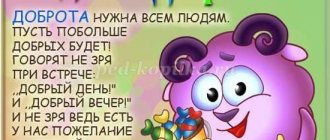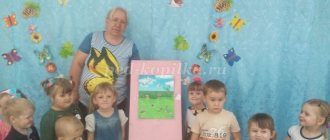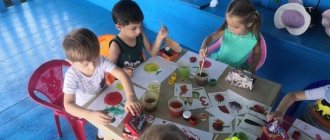Progress of direct educational activities
Topic: “In a world of kindness ”
.
Goal: to deepen children's understanding of kindness as a valuable, integral quality of a person, to promote team unity, to motivate children to do good deeds , good deeds for the benefit of other people.
Educational tasks:
• Form friendly , friendly relationships between children;
• Develop the ability to evaluate the actions of others;
• Develop a negative perception and attitude towards bad actions in life;
• Encourage children's desire to do good deeds ;
• Preservation and promotion of children's health.
Developmental tasks: develop memory, speech, creative imagination, fine motor skills and hand coordination, the ability to listen to the teacher.
Educational objectives: to give children an idea of the concept of “ good ”
,
“evil”
, their importance in people’s lives;
consolidate children's knowledge about the properties and qualities of visual material; continue to introduce the technique of unconventional drawing - “Drawing with a stamp”
: learn to dip a stamp in paint, apply it to a sheet of paper;
fix color (yellow)
; learn to admire the finished drawing.
Main educational area: cognition.
Integrative educational areas: communication, socialization.
Methods and techniques:
Verbal: conversation, question - answer, thesis speech repetition of phrases, artistic expression.
Game: surprise moment.
Visual: slide show, “bag
of kindness ” (seeds, broken car, torn book, dirty dishes)
.
Practical: drawings.
Preliminary work: examination of illustrations for fairy tales depicting good and evil heroes , ethical conversations using visual teaching aids “Lessons of Kindness ”
, learning poems on the topic, reading and explaining the meaning of proverbs and sayings about
kindness , observing the actions of adults and children, encouraging children to express a kind attitude towards others.
Equipment: audio recording with songs “Friends”
(
Barbarika group , song “Smile”
, meditative music, musical physical education,
multimedia projector, presentation, safe candle, “bag
of kindness ” (seeds, broken car, torn book, dirty toy dishes)
.
Handouts: sheets of paper with drawn flower stems, plates with diluted yellow gouache, stamps, napkins according to the number of children.
Structure:
1. Organizational moment.
Goal: Creating a favorable emotional and psychological environment. activating children's attention. Game “Give each other a spark of kindness ”
.
The goal of the game: unity and caring attitude towards each other.
2. Conversation. Presentation: “Game “ Good and bad deeds ”
».
Goal: to develop children’s coherent speech, to practice establishing cause-and-effect relationships based on plot pictures, to teach them to evaluate and analyze the actions of others and life situations.
3. Game “Bag of Kindness ”
.
Goal: to encourage children to act morally.
4. Musical physical education.
Goal: Changing the type of activity, preventing fatigue, developing motor skills.
5. Practical work. Non-traditional drawing - “drawing with a stamp”
“
Good Glade of Flowers ” .
Goal: To introduce children to the technique of stamp printing, develop creative imagination, attention, fine motor skills and hand coordination, and cultivate interest in creativity.
6. Summary of the lesson . Purpose: to convey to children the importance of this topic, to encourage the desire to do good deeds .
Routing
directly educational activities
Group : medium
Educator: E. G. Kayurova
Topic: “In a world of kindness ”
.
Goal: to deepen children's understanding of kindness as a valuable, integral quality of a person, to promote team unity, to motivate children to do good deeds , good deeds for the benefit of other people.
Objectives: to give children an idea of the concept of “ good ”
,
“evil”
, their importance in people’s lives;
consolidate children's knowledge about the properties and qualities of visual material; continue to introduce the technique of unconventional drawing - “Drawing with a stamp”
: learn to dip a stamp in paint, apply it to a sheet of paper;
fix color (yellow)
; learn to admire the finished drawing.
Preliminary work: examination of illustrations for fairy tales depicting good and evil heroes , ethical conversations using visual teaching aids “Lessons of Kindness ”
, learning poems on the topic, reading and explaining the meaning of proverbs and sayings about
kindness , observing the actions of adults and children, encouraging children to express a kind attitude towards others.
.Stage, its duration Objectives of the stage Activities of the teacher Activities of students Methods, forms, techniques, possible types of activities Result
Psychological mood, 1 min (surprise moment with the appearance of the Fairy of Kindness )
.Creating an atmosphere of psychological safety: empathic acceptance, emotional support for the child Play gymnastics:
“Give each other a spark of
kindness . ”
Softly pronouncing the word “ good ”
, accompaniment with gestures. Game moment. Psychological readiness
Motivational and incentive, 1-2 min Formation of ideas about the upcoming activity, its tasks About whom or what you can say “ kind ”
;
Good man , what is he like?
Can you touch kindness , does it have a smell, taste? Participate in dialogue, express their opinions based on existing ideas. Conversation Formal readiness for upcoming activities, attracting voluntary attention
Updating 5 min (viewing presentation with story pictures)
Updating existing knowledge and ideas. Creating a situation in which there is a need to acquire new ideas and skills Questions: A girl feeds a fawn. -A good deed? The boy insults the dog. -A good deed? The guys want to return the chick to the nest. -Are they doing a good job? A boy runs along a forest path, screams at the top of his lungs and all the animals run away. -Is he doing the right thing? The daughter meets her dad and gives her slippers. -A good deed?
When a person does good deeds and deeds , what kind of face does he have at that moment?
Activation of the dictionary. They understand and accept the task: they offer different answer options. Conversation, observations Reproduction of information necessary for the successful assimilation of new things.
Perception and assimilation of new things (or expansion of existing ideas, 5 min. Game “Bag of Kindness ”
.
Assimilation (consolidation, expansion, generalization, systematization)
of a certain amount of knowledge and ideas about the properties and qualities of objects, their transformation, connections, methods of action, etc. Explanation, storytelling, organization of search activities: what good can be
done after seeing these objects (seeds, torn book, broken car, dirty dishes)
.
Organization of interaction in achieving results. They watch and examine. Participate in the discussion of the question asked. Techniques for activating children's independent actions.
Game, etc. Conscious, learned concepts, formed ideas, patterns, abilities, skills, etc. Mastery of methods of cognitive activity. Ability to independently solve age-appropriate intellectual problems. Curiosity and activity
Dynamic pause, 1 min. (Musical physical education minute)
Changing the type of activity, preventing fatigue Conducting musical physical education. Participate in games and do physical exercises. Game techniques Relieve tension, emotional and physical release. Getting a new gaming experience.
Practical work 5 min (non-traditional drawing “drawing with a stamp”
. Mastering methods of action, applying knowledge, skills and abilities Organization of practical work: examines with children drawn flower stems on leaves, leaves, introduce children to the technique of stamp printing. They look at the drawn flower stems on leaves, listen to instructions on drawing techniques, and draw flower petals in a certain place. Doing practical work. Mastering a certain amount of practical skills and abilities when teaching productive activities.
Reflective-corrective (for educational activities in which practical work predominates, 1 min. Correction, if necessary, of activities and results in accordance with the assigned tasks. Checking the results obtained in the production of drawings. Self-test. Fantasize what the “Good Glade of Flowers” turned out to be )
. Frontal, individual work.
Development of basic self-control skills. Mastering the universal prerequisites for educational activities - the ability to work according to rules and patterns, listen to an adult and follow his instructions
Bottom line. 1 min. Consolidating acquired knowledge about kindness as a valuable, integral quality of a person. Leads children to the conclusion about how it is necessary to do good deeds . Gives pictures - suns, as a symbol of warmth, kindness and light . Answers to questions sum up the educational activity. Express their opinions. Conversation: question and answer. Improved speech skills. Acquired knowledge of goodness .








